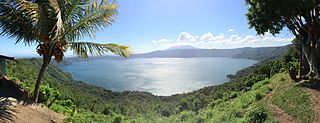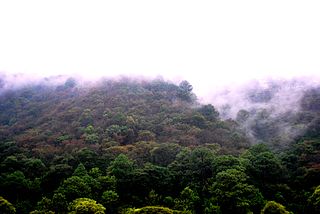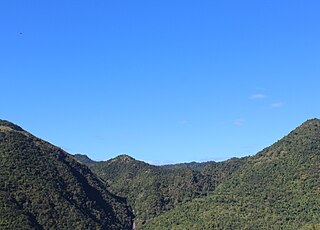Related Research Articles

A nature reserve is a protected area of importance for flora, fauna, or features of geological or other special interest, which is reserved and managed for purposes of conservation and to provide special opportunities for study or research. They may be designated by government institutions in some countries, or by private landowners, such as charities and research institutions. Nature reserves fall into different IUCN categories depending on the level of protection afforded by local laws. Normally it is more strictly protected than a nature park. Various jurisdictions may use other terminology, such as ecological protection area or private protected area in legislation and in official titles of the reserves.

Juigalpa is the municipal seat of Juigalpa Municipality and the capital city of the Chontales Department of Nicaragua. It is located within the municipality of Juigalpa, approximately 140 km east of Managua on Carretera Rama, in the central region of Nicaragua.
The Bosawás Biosphere Reserve in the northern part of state Jinotega, Nicaragua is a hilly tropical forest designated in 1997 as a UNESCO biosphere reserve. At approximately 20,000 km² in size, the reserve comprises about 15% of the nation's total land area. Combined with the biosphere of the banana river in Honduras, which is continguous with the jungle of the Bosawás reserve, it is the second largest rainforest in the Western Hemisphere, after the Amazon in Brazil. Bosawás is largely unexplored, and is extremely rich in biodiversity.

The fauna of Nicaragua is characterized by a very high level of biodiversity. Much of Nicaragua's wildlife lives in protected areas. There are currently 78 protected areas in Nicaragua, covering more than 22,000 square kilometers (8,500 sq mi), or about 17% of its landmass.
National System of Protected AreasSINAP, is the Nicaraguan national parks administrator, and is part of the Nicaraguan Ministry of Environment and Natural Resources (MARENA).

Tourism in Nicaragua has grown considerably recently, and it is now the second largest industry in the nation. Nicaraguan President Daniel Ortega has stated his intention to use tourism to combat poverty throughout the country.
Indio Maíz Biological Reserve is situated on the southeastern corner of Nicaragua bordering the San Juan River and Costa Rica. Measuring about 3,180 square kilometers, it is one of the largest protected lowland forest system in Central America, the second largest lowland rainforest reserve in Nicaragua and is a key component in the proposed Mesoamerican Biological Corridor. It has previously been referred to as "the gem of Central American nature reserves" by UCLA biologists. Indio Maíz is rich in biodiversity, holding a higher number in species of trees, birds, and insects than all of Europe. In recent years, a growing timber and oil palm industry has led to increasing rates of deforestation along the northern and western flanks of Indio Maíz.

The protected areas of Nicaragua are areas that have natural beauty or significance and are protected by Nicaragua. Nicaragua has 78 protected areas that cover 22,422 km2, about 17.3% of the nations landmass. The National System of Protected Areas (SINAP) is administered by the Ministry of the Environment and Natural Resources (MARENA).

Chocoyero-El Brujo Natural Reserve is located in the municipality of Ticuantepe in the Managua department of Nicaragua. Chocoyero-El Brujo is one of 78 protected areas in Nicaragua, and at just 455 acres (1.8 km2) this tropical forest is one of the smallest in size. Chocoyero-El Brujo was declared a natural reserve in 1993 is managed by the Ministry of the Environment and Natural Resources (MARENA).
Cerro Arenal Natural Reserve is a natural reserve with an area of 14.28 square kilometres in the Cordillera Dariense, it is located in the Matagalpa department in central Nicaragua.

Laguna de Apoyo Nature Reserve is a nature reserve located between the departments of Masaya and Granada in Nicaragua. Lake Apoyo was declared a nature reserve in 1991 and is managed by the Ministry of the Environment and Natural Resources (MARENA) and comprises one of 78 protected areas of Nicaragua. Activities within the Laguna de Apoyo Nature Reserve are regulated by its management plan, approved in 2010, which prohibits the construction of housing within the reserve and use of motorized vehicles on the lake. Geological data suggests that Lake Apoyo originated about 23,000 years ago.

The Central American pine–oak forests is a tropical and subtropical coniferous forests ecoregion in the mountains of northern Central America and Chiapas state in southern Mexico.
Chiltepe Peninsula Natural Reserve is a nature reserve in Nicaragua. It is one of the 78 reserves which are officially under protection in the country.
Limbaika Natural Reserve is a nature reserve in Nicaragua. It is one of the 78 reserves that are under official protection in the country.
Río San Juan Wildlife Refuge is a nature reserve in Nicaragua. It is one of the 78 reserves which are officially under protection in the country. It consists of 430 km2 (170 sq mi).
Sierra Quirragua Natural Reserve is a nature reserve in Nicaragua. It is one of the 78 reserves that are under official protection in the country.

Tepesomoto–Pataste Nature Reserve is a nature reserve in Nicaragua. It is one of the 78 reserves that are under official protection in the country.

La Sepultura is a biosphere reserve in southern Mexico. It protects a portion of the Sierra Madre de Chiapas range in the state of Chiapas.

The Planadas-Yeyesa Nature Reserve is a protected nature reserve located in the Sierra de Cayey, in the municipalities of Cayey and Salinas in central Puerto Rico. The reserve is located close to the famous Cerro Las Tetas. Two of the most prominent features of the reserve are Cerro Planada, a 2,480 feet high mountain peak, and La Yeyesa, a heavily forested canyon formed by the Lapa River and other streams which feed into the Nigua River. La Yeyesa can be accessed through a lightly trafficked yet moderate trail.

La Robleda Natural Protected Area is a 254-acre protected natural area and conservation easement in Cayey, Puerto Rico. La Robleda, meaning 'the oak grove', gets its name from the high concentration of pink manjack trees, locally known as roble blanco, in the area. The pink manjack trees in this nature reserve bloom for a few weeks every year, creating a natural scenic spectacle of pink and white colors in the Sierra de Cayey.